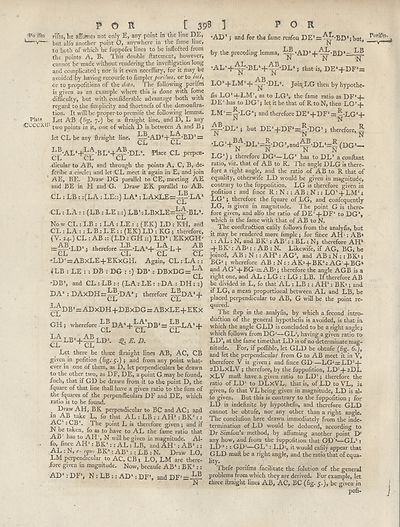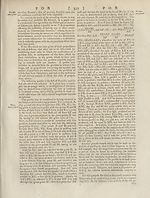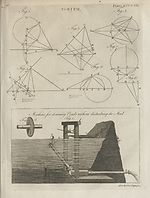Encyclopaedia Britannica > Volume 15, PLA-RAM
(442) Page 398
Download files
Complete book:
Individual page:
Thumbnail gallery: Grid view | List view

P O R [
-Po ifm rlfm, he affufnes not onljT E, any point !n the line DE,
but alfo another point Q, anywhere in the fame line,
to both of which he fuppofes lines to be inflefted from
the points -A., E. i his double ftatement, however,
cannot be made without rendering the inveftigation long
and complicated ; nor is it even necefiary, for it may be
avoided by having recourfe to fimpler peri'ms, or to /oci,
or to propofitions of the data, 1 he following porifm
is given as an example where this is done with fome
difficulty, but with confiderable advantage both with
regard to the fimplicity and fhortnefs of the demonllra-
tion. It will'be proper to premife the following lemma.
Plate J^et AB (frg. 7.) be a ftraight line, and D, L any
CCCCXL (W0 points in it, one of which X) is between A and B}
let CL be any ftraight line,
393 i
AD’;
P o
•BDJ =
ecAL‘4c'BL‘+^'DL’
CL
Place CL perpen-
dicular to AB, and through the points A, C, B, de-
feribe a circle; and let CL meet it again in E, and join
AE, BE. Draw DG parallel to CE, meeting AE
and BE in H and G. Draw EK. parallel to AB.
CL : LB : :(LA : LE::) LA*: LAxLE=:-i? LA*
JLj
CL : LA :: (LB : LE;:) LB’:LBxLE=^-BL*.
Now CL : LB ; : LA ; LE : : (EK) LD : KH, and
CL : LA : : L B : L E :: (EK) LD ; KG; therefore,
(V. 24.) CL : AB :: (LD; GH ;;) LD*: EKxGH-
AB T -p., , r LB t a * 1 LA r , AB
~Cl’LD J thercforc CL LA + cl L+ cl
*LD’=ABxLE+EKxGH. Again, CL ; LA :;
) DB‘;DBXDG=^
and CL : LB :: (LA: LE : : DA : DH; :)
therefore ^^DA*-}-
4 LB : LE : : DB : DG
*DB
DA3
DAxDH=~-DA
LA
CL
GH;
CL
DB1=ADxDH+DBxDG=ABxLE+EKx
wherefore LB DA*4--^!dB*= ^LA*4-
CL ^ CL CL ^
— LB3
CL
4-^LD3
‘ CL
^E.D.
Let there be three ftraight lines AB, AC, CB
given in pofition (fig. 5.) ; and from any point what¬
ever in one of them, as D, let perpendiculars be drawn
to the other two, as DF, DE, a point G may be found,
fuch, that if GD be drawn from it to the point D, the
fquare of that line fhall have a given ratio to the fum of
the fquares of the perpendiculars DF and DE, which
ratio is to be found.
Draw AH, BK perpendicular to BC and AC; and
in AB take L, fo that AL : LB : : AH* : BK2:;
AC :CB*. The point L is therefore given; and if
N be taken, fo as to have to AL the fame ratio that
AB has to AH , N will be given in magnitude. Al¬
fo, frnce AH*: BK*:; AL : LB, and AH *: AB* :;
AL : N, <?> equo BK*: AB*: : LB ; N. Draw LO,
LM perpendicular to AC, CB; LO, LM are there¬
fore given in magnitude. Now, becaufe AB*: BK*:;
AD*; DF*, N: LB :: AD* iDF*, andDF^z:—
N
R
•pt — AL.
and for the fame reafon DE*=-^'•BD,;butl
by the preceding lemma, —?-,AD*4-^i'-BD*“
1 r 6 N N N
•AL-+4^-BL-+M-DL> J that is, DE*+DF-=
Join LG then by hypothe-
Porifm ^
N
LO*+LM*+^-DL3
N
iis LO1 -4-LM , as to LG*, the fame ratio as DF*-|«
DE* has to DG’; let it be that of RtoN, then LO*-f
LhLzz ji-LG*; and therefore DE*-f.DF*=^-LG*-f
^•DL*; but DE*-fDF* = ?-DG*; therefore, 5
•I.G'+BNA-DL‘=|-DG%and^-DL'=|(DG--
LG*) ; therefore DG1—LG* has to DL* a conftant
ratio, viz. that of AB to R. The angle DLG is there¬
fore a right angle, and the ratio of AB to R that of
equality, otherwife LD would be given in magnitude,
contrary to the fuppofition, LG is therefore given in
pofition ; and fince R : N : : AB : N :: LO3 -f LM*;
LG3 ; therefore the fqnare of LG, and confequently
LG, is given in magnitude. The point G is there¬
fore given, and alfo the ratio of DE*-f-DF* to DG*,
which is the fame with that of AB to N.
The conftru£tion calily follows from the analyfis, but
it may be rendered more limple ; for fince AH-1: AB*
:: AL : N, and BK*: AB3: : BL ; N; therefore AH*
+ BIC: AB*;: AB : N. Like wife, if AG, BG, be
joined, AB ; N :: AH*: AG2, and AB : N :: BK*:
BG1; wherefore AB : N:: AK2-j-BK2: AG-f-BG*
and AG2-1-BG =AB*; therefore the angle AGB is a
right one, and AL; LG : : LG : LB. If therefore AB
be divided in L, fo that AL : LB : ; AH*; BK*; and
if LG, a mean proportional between AL and LB, be
placed perpendicular to AB, G will be the point re¬
quired.
d he ftep in the analyfis, by which a fecond intro-
du&ion of the general hypothefis is avoided, is that in
which the angle GLD is concluded to be a right angle;
which follows from DG2—GL2, having a given ratio to
LD2, at the fame timethat LD is of no determinate mag¬
nitude. For, if poffible, let GLD be obtufe (fig. 6.),
and let the perpendicular from G to AB meet it in V,
therefore V is given: and fince GD —LG2=LD2-j-
2DLXLV ; therefore, by the fuppofition, LD2-f-2DL
XLV muft have a given ratio to LD3; therefore the
ratio of LD2 to DLxVL, that is, of LD toVL, i&
given, fo that VL being given in magnitude, LD is al¬
fo given. But this is contrary to the fuppofition ; for
LD is indefinite by hypothefis, and therefore GLD
cannot be obtufe, nor any other than a right angle.
The conclufion here drawn immediately from the inde¬
termination of LD would be deduced, according to
Dr Simfon’s method, by affuming another point D'
any how, and from the fuppofition that GD'*—GL2 i
LD'2: : GD‘—GL‘: LD-’, it would eafily appear that
GLD muft be a right angle, and the ratio that of equa¬
lity.
Thefe porifms facilitate the folution of the general
problems from which they are derived. For example, let
three ftraight lines AB, AC, BC (fig. 5.), be given in
poll-
-Po ifm rlfm, he affufnes not onljT E, any point !n the line DE,
but alfo another point Q, anywhere in the fame line,
to both of which he fuppofes lines to be inflefted from
the points -A., E. i his double ftatement, however,
cannot be made without rendering the inveftigation long
and complicated ; nor is it even necefiary, for it may be
avoided by having recourfe to fimpler peri'ms, or to /oci,
or to propofitions of the data, 1 he following porifm
is given as an example where this is done with fome
difficulty, but with confiderable advantage both with
regard to the fimplicity and fhortnefs of the demonllra-
tion. It will'be proper to premife the following lemma.
Plate J^et AB (frg. 7.) be a ftraight line, and D, L any
CCCCXL (W0 points in it, one of which X) is between A and B}
let CL be any ftraight line,
393 i
AD’;
P o
•BDJ =
ecAL‘4c'BL‘+^'DL’
CL
Place CL perpen-
dicular to AB, and through the points A, C, B, de-
feribe a circle; and let CL meet it again in E, and join
AE, BE. Draw DG parallel to CE, meeting AE
and BE in H and G. Draw EK. parallel to AB.
CL : LB : :(LA : LE::) LA*: LAxLE=:-i? LA*
JLj
CL : LA :: (LB : LE;:) LB’:LBxLE=^-BL*.
Now CL : LB ; : LA ; LE : : (EK) LD : KH, and
CL : LA : : L B : L E :: (EK) LD ; KG; therefore,
(V. 24.) CL : AB :: (LD; GH ;;) LD*: EKxGH-
AB T -p., , r LB t a * 1 LA r , AB
~Cl’LD J thercforc CL LA + cl L+ cl
*LD’=ABxLE+EKxGH. Again, CL ; LA :;
) DB‘;DBXDG=^
and CL : LB :: (LA: LE : : DA : DH; :)
therefore ^^DA*-}-
4 LB : LE : : DB : DG
*DB
DA3
DAxDH=~-DA
LA
CL
GH;
CL
DB1=ADxDH+DBxDG=ABxLE+EKx
wherefore LB DA*4--^!dB*= ^LA*4-
CL ^ CL CL ^
— LB3
CL
4-^LD3
‘ CL
^E.D.
Let there be three ftraight lines AB, AC, CB
given in pofition (fig. 5.) ; and from any point what¬
ever in one of them, as D, let perpendiculars be drawn
to the other two, as DF, DE, a point G may be found,
fuch, that if GD be drawn from it to the point D, the
fquare of that line fhall have a given ratio to the fum of
the fquares of the perpendiculars DF and DE, which
ratio is to be found.
Draw AH, BK perpendicular to BC and AC; and
in AB take L, fo that AL : LB : : AH* : BK2:;
AC :CB*. The point L is therefore given; and if
N be taken, fo as to have to AL the fame ratio that
AB has to AH , N will be given in magnitude. Al¬
fo, frnce AH*: BK*:; AL : LB, and AH *: AB* :;
AL : N, <?> equo BK*: AB*: : LB ; N. Draw LO,
LM perpendicular to AC, CB; LO, LM are there¬
fore given in magnitude. Now, becaufe AB*: BK*:;
AD*; DF*, N: LB :: AD* iDF*, andDF^z:—
N
R
•pt — AL.
and for the fame reafon DE*=-^'•BD,;butl
by the preceding lemma, —?-,AD*4-^i'-BD*“
1 r 6 N N N
•AL-+4^-BL-+M-DL> J that is, DE*+DF-=
Join LG then by hypothe-
Porifm ^
N
LO*+LM*+^-DL3
N
iis LO1 -4-LM , as to LG*, the fame ratio as DF*-|«
DE* has to DG’; let it be that of RtoN, then LO*-f
LhLzz ji-LG*; and therefore DE*-f.DF*=^-LG*-f
^•DL*; but DE*-fDF* = ?-DG*; therefore, 5
•I.G'+BNA-DL‘=|-DG%and^-DL'=|(DG--
LG*) ; therefore DG1—LG* has to DL* a conftant
ratio, viz. that of AB to R. The angle DLG is there¬
fore a right angle, and the ratio of AB to R that of
equality, otherwife LD would be given in magnitude,
contrary to the fuppofition, LG is therefore given in
pofition ; and fince R : N : : AB : N :: LO3 -f LM*;
LG3 ; therefore the fqnare of LG, and confequently
LG, is given in magnitude. The point G is there¬
fore given, and alfo the ratio of DE*-f-DF* to DG*,
which is the fame with that of AB to N.
The conftru£tion calily follows from the analyfis, but
it may be rendered more limple ; for fince AH-1: AB*
:: AL : N, and BK*: AB3: : BL ; N; therefore AH*
+ BIC: AB*;: AB : N. Like wife, if AG, BG, be
joined, AB ; N :: AH*: AG2, and AB : N :: BK*:
BG1; wherefore AB : N:: AK2-j-BK2: AG-f-BG*
and AG2-1-BG =AB*; therefore the angle AGB is a
right one, and AL; LG : : LG : LB. If therefore AB
be divided in L, fo that AL : LB : ; AH*; BK*; and
if LG, a mean proportional between AL and LB, be
placed perpendicular to AB, G will be the point re¬
quired.
d he ftep in the analyfis, by which a fecond intro-
du&ion of the general hypothefis is avoided, is that in
which the angle GLD is concluded to be a right angle;
which follows from DG2—GL2, having a given ratio to
LD2, at the fame timethat LD is of no determinate mag¬
nitude. For, if poffible, let GLD be obtufe (fig. 6.),
and let the perpendicular from G to AB meet it in V,
therefore V is given: and fince GD —LG2=LD2-j-
2DLXLV ; therefore, by the fuppofition, LD2-f-2DL
XLV muft have a given ratio to LD3; therefore the
ratio of LD2 to DLxVL, that is, of LD toVL, i&
given, fo that VL being given in magnitude, LD is al¬
fo given. But this is contrary to the fuppofition ; for
LD is indefinite by hypothefis, and therefore GLD
cannot be obtufe, nor any other than a right angle.
The conclufion here drawn immediately from the inde¬
termination of LD would be deduced, according to
Dr Simfon’s method, by affuming another point D'
any how, and from the fuppofition that GD'*—GL2 i
LD'2: : GD‘—GL‘: LD-’, it would eafily appear that
GLD muft be a right angle, and the ratio that of equa¬
lity.
Thefe porifms facilitate the folution of the general
problems from which they are derived. For example, let
three ftraight lines AB, AC, BC (fig. 5.), be given in
poll-
Set display mode to:
![]() Universal Viewer |
Universal Viewer | ![]() Mirador |
Large image | Transcription
Mirador |
Large image | Transcription
Images and transcriptions on this page, including medium image downloads, may be used under the Creative Commons Attribution 4.0 International Licence unless otherwise stated. ![]()
| Encyclopaedia Britannica > Encyclopaedia Britannica > Volume 15, PLA-RAM > (442) Page 398 |
|---|
| Permanent URL | https://digital.nls.uk/191906522 |
|---|
| Attribution and copyright: |
|
|---|
| Description | Ten editions of 'Encyclopaedia Britannica', issued from 1768-1903, in 231 volumes. Originally issued in 100 weekly parts (3 volumes) between 1768 and 1771 by publishers: Colin Macfarquhar and Andrew Bell (Edinburgh); editor: William Smellie: engraver: Andrew Bell. Expanded editions in the 19th century featured more volumes and contributions from leading experts in their fields. Managed and published in Edinburgh up to the 9th edition (25 volumes, from 1875-1889); the 10th edition (1902-1903) re-issued the 9th edition, with 11 supplementary volumes. |
|---|---|
| Additional NLS resources: |
|

